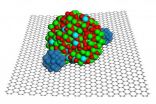(Press-News.org) LA JOLLA, CA – February 8, 2011 - A team of scientists from The Scripps Research Institute and the University of California, San Diego (UCSD) have developed a novel technique to observe previously unknown details of how folded structures are formed from an intrinsically disordered protein. The insights could help scientists to better understand the mechanism of plaque formation in neurodegenerative disorders such as Parkinson's and Alzheimer's diseases.
The results of the study, which has broad implications for the field, were recently published in an advanced, online issue of the journal Nature Methods.
The new technique allows previously unheard-of rapid detection—in less than 0.001 seconds—of transiently folded single-molecule structures from a class of often-amorphous molecules known as "intrinsically disordered proteins." The method also permits new types of observations of short-lived protein complexes.
"This exciting new technique allowed us to visualize multiple short-lived folded states," said Scripps Research Associate Professor Ashok Deniz, Ph.D., who led the study with UCSD Professor Alex Groisman, Ph.D., and Yann Gambin, Ph.D., of Scripps Research. "Further, better understanding of complexity during folding may offer more ways to regulate this interesting class of proteins."
The specific protein examined in the study was -synuclein, which is highly concentrated in neural tissue. The protein has been implicated in Parkinson's and Alzheimer's diseases, as it is found in high concentrations in aggregates from the brains of patients with these conditions.
Mixing It Up
Unlike typical proteins in the cell, intrinsically disordered proteins such as -synuclein do not adopt a stable globular form in isolation. Rather, intrinsically disordered proteins are like a messy, unfolded string of yarn, whereas typical globular proteins more closely resemble yarn neatly knit into complicated and functional shapes like that of a glove.
Studying intrinsically disordered proteins has been a challenge. Known techniques to determine protein structures are often designed for ordered proteins, and detection of transient shapes in structurally heterogenous proteins such as -synuclein has been difficult. To remedy this situation, the Deniz and Groisman labs set out to devise advanced technologies to shed light on this novel class of proteins.
The new experimental technique described in the Nature Methods paper successfully combines and improves upon two established experimental methods: single-molecule Förster Resonance Energy Transfer (smFRET) and microfludic mixing.
smFRET detection allows for the observation of very small distances (in the range of one billionth of a meter), and can reveal changes in the molecular structure in real time. The method works by transfer of energy between single fluorescent dye molecules used as tags on a protein. One dye (donor) absorbs light and can emit red-shifted fluorescent light, whereas the other dye (acceptor) can receive the energy from the donor and emit even more red-shifted light. The relative amount of light emitted by the two dyes depends on the distance between them, and hence can be used as a molecular ruler to measure distances in proteins. Microfluidic mixing in high-speed laminar flows has been used previously to rapidly initiate protein-folding reactions, but most observations have been made on a bulk rather than single-molecule level.
Detecting Protein Folding in a Chip
The key innovation of the research was to combine rapid mixing in a high-speed flow with single-molecule detection in a slow flow by abruptly decelerating the flow between mixing and detection regions.
The protein started in an aqueous solution and was mixed with a substance known as sodium dodecyl sulfate (SDS), which is normally used to unfold proteins but also facilitates the folding of -synuclein due to its special interactions with amphipathic environments. This combination of rapid mixing and detection enabled the discovery of short-lived protein states previously invisible to researchers.
The microfluidic mixing itself was performed inside a small chip housing several hollow channels (or tunnels). The main channel is like a freeway upon which the protein travels. This channel connects at junction points to other inlets (on-ramps to the freeway) or outlets (off-ramps from the freeway).
The two inlets were used to funnel buffer and SDS into the central stream, effectively focusing the central protein stream into a narrow, fast-moving lane, and allowing a rapid switch into a solution containing SDS. Further along the channel at another junction, two outlets forced most of the "traffic" to exit. As a result, the speed of the remaining central part of the stream, or central lane, abruptly decreased.
Protein molecules in this slower, focused stream of protein were then detected by smFRET. The rapid slowing was a critical new element in the method, providing just enough time for scientists to examine individual slower-moving proteins as they passed by the detector. A movie of the proteins' changing shapes could be recorded over time.
At the inlet (on-ramp), -synuclein was introduced to negatively charged SDS, and -synuclein began to fold. Combined with the rapid mixing, the fluorescence from the dye tags—which had been placed far apart on -synuclein—revealed previously unknown details of transiently folded structures of -synuclein, observed in the sub-millisecond timeframe.
Dynamic Conditions
Prior to this work, the equilibrium state of -synuclein in the SDS-containing solution was known to be an extended helix (like the coil of a phone cord) called the F state. This ordered structure exists in the presence of the negatively charged biological membrane or SDS.
"So the question was: 'Do we go directly from the disordered protein to that F state?'" said Deniz. "And the answer from our experiments was, 'No.' We visit an intermediate structure, which has a similar FRET efficiency to what was previously observed to be a helix-kink-helix (I state), like a coil with a kink that bends the coil into a U-shape instead of a straight coil. Surprisingly, even this initial transition is complex, and provides us views of how the protein shape changes soon after binding to its partner molecules. What this means is that, as conditions in the cell are dynamic, these new states might give us many more points of regulation of -synuclein."
Next in the lab's research, Deniz plans to examine questions including: "Do different -synuclein structures aggregate differently, and how do they couple to function?" "What triggers the aggregation?" "What exactly are the roles of aggregates?" and "What kinds of structures will be detected for -synuclein interacting with other protein, lipid, and small-molecule partners?"
In addition, Deniz believes the developed microfluidic method will improve scientists' understanding of complexity in many other biological and health-related molecules.
###In addition to Deniz, Groisman, and Gambin (now at the University of Queensland, Australia), authors of the paper, "Visualizing a one-way protein encounter complex by ultrafast single-molecule mixing," included Virginia VanDelinder of UCSD (now at the European Molecular Biology Laboratory), Allan Chris M. Ferreon of Scripps Research, and Edward A. Lemke of Scripps Research (now at the European Molecular Biology Laboratory). For more information, see http://www.nature.com/nmeth/journal/vaop/ncurrent/abs/nmeth.1568.html .
This work was supported by grants from the National Institutes of Health and the National Science Foundation, and a postdoctoral fellowship from the National Institutes of Health; funding by the German Research Foundation is also acknowledged.
About The Scripps Research Institute
The Scripps Research Institute is one of the world's largest independent, non-profit biomedical research organizations, at the forefront of basic biomedical science that seeks to comprehend the most fundamental processes of life. Scripps Research is internationally recognized for its discoveries in immunology, molecular and cellular biology, chemistry, neurosciences, autoimmune, cardiovascular, and infectious diseases, and synthetic vaccine development. An institution that evolved from the Scripps Metabolic Clinic founded by philanthropist Ellen Browning Scripps in 1924, Scripps Research currently employs approximately 3,000 scientists, postdoctoral fellows, scientific and other technicians, doctoral degree graduate students, and administrative and technical support personnel. Headquartered in La Jolla, California, the institute also includes Scripps Florida, whose researchers focus on basic biomedical science, drug discovery, and technology development. Scripps Florida is located in Jupiter, Florida. For more information, see www.scripps.edu
Scientists develop method to identify fleetingly ordered protein structures
The findings may enable scientists to better understand the molecular biology and biophysics of the brain and diseases such as Alzheimer's and Parkinson's
2011-02-09
ELSE PRESS RELEASES FROM THIS DATE:
New techniques for stapling peptides could spur development of drugs for cancer
2011-02-09
BUFFALO, N.Y. -- Researchers at the University at Buffalo have devised two new ways of "stapling" peptide helices to prevent these medically important molecules from losing their shape and degrading in the presence of enzymes.
The discovery could help speed the development of peptide-based drugs against diseases including cancer. UB scientists say the methods they pioneered are simpler than existing techniques, one of which employs an expensive ruthenium catalyst to connect chemical side chains that protrude from the main body of helical peptides.
"There's a lot of potential ...
Gene protects lung from damage due to pneumonia, sepsis, trauma, transplants
2011-02-09
Lung injury is a common cause of death among patients with pneumonia, sepsis or trauma and in those who have had lung transplants. The damage often occurs suddenly and can cause life-threatening breathing problems and rapid lung failure.
There are no effective treatments. Patients usually are put on ventilators to give their lungs a chance to heal, but there is little else doctors can do but wait and hope for the best.
Now, researchers at Washington University School of Medicine in St. Louis report they have identified a gene that limits damage to the lung during acute ...
Electronic cigarettes hold promise as aid to quitting
2011-02-09
A study led by Boston University School of Public Health (BUSPH) researchers reports that electronic cigarettes are a promising tool to help smokers quit, producing six-month abstinence rates nearly double those for traditional nicotine replacement products.
In a study published online ahead of print in the American Journal of Preventive Medicine, researchers found that 31 percent of respondents reported having quit smoking six months after first purchasing an electronic cigarette, a battery-powered device providing tobacco-less doses of nicotine in a vaporized solution. ...
Not just for raincoats
2011-02-09
Researchers from Northwestern University and the Massachusetts Institute of Technology (MIT) have studied individual water droplets and discovered a miniature version of the "water hammer," an effect that produces the familiar radiator pipe clanging in older buildings.
In piping systems, the water hammer occurs when fluid is forced to stop abruptly, causing huge pressure spikes that can rupture pipe walls. Now, for the first time, the researchers have observed this force on the scale of microns: such pressure spikes can move through a water droplet, causing it to be impaled ...
Growing population of adult survivors of congenital heart disease requires specialized care
2011-02-09
Philadelphia, PA, February 8, 2011 – For the one in 200 adults in Western societies born with congenital heart disease, adult survivors face a lifelong process of medical interactions. Treatments received during neonatal, childhood, and adolescent years affect future adult events. In the January/February issue of Progress in Cardiovascular Diseases ten articles explore our current understanding of adult congenital heart disease (ACHD) in survivors.
This issue of Progress in Cardiovascular Diseases is dedicated to exploring the path to and current understanding of lifelong ...
Medication education key to successful adherence in patients with diabetes
2011-02-09
Researchers at the Skaggs School of Pharmacy and Pharmaceutical Sciences at the University of California, San Diego say that medication education is a key factor in helping patients with diabetes better stick to their drug treatments plans. The study, currently on line in the February issue of the journal Annals of Pharmacotherapy, points to the need for pharmacists and other health care providers to assess reasons why some patients don't adhere to their medication plans, and to provide counseling opportunities to help them.
"Counseling can be more effective if pharmacists ...
A paperweight for platinum
2011-02-09
RICHLAND, Wash. -- A new combination of nanoparticles and graphene results in a more durable catalytic material for fuel cells, according to work published today online at the Journal of the American Chemical Society. The catalytic material is not only hardier but more chemically active as well. The researchers are confident the results will help improve fuel cell design.
"Fuel cells are an important area of energy technology, but cost and durability are big challenges," said chemist Jun Liu. "The unique structure of this material provides much needed stability, good ...
Understanding patterns of seafloor biomass
2011-02-09
Analysis of a comprehensive database has revealed strong links between biological productivity in the surface oceans and patterns of biomass and abundance at the seafloor, helping to explain large regional differences. The research was conducted by an international, multi-institutional research team including scientists from the National Oceanography Centre (NOC), and incorporated data from the Census of Marine Life (CoML).
The vast majority of the biological production in the world's oceans occurs within sunlit surface waters – the so-called photic zone. Through the ...
Cross-border conservation vital to protect birds in a climate-change world
2011-02-09
Countries need to increase co-operation over conservation to protect birds and other wildlife in an era of climate change, according to a new continental-scale study.
Experts have established a new conservation index to help policy-makers to deal with the effects of climate change on birds in Africa, and it could assist governments across the world to protect wildlife areas and help species as climate change forces them to move to new areas.
It is the first categorisation of protected areas to show how conservationists might deal with climate change and the shuffling ...
Virtual laboratory predicts train vibrations
2011-02-09
The construction of new rail lines, or the relocation of old ones underground, has increased society's interest over recent years in the vibrations produced by trains, especially among people who live or work near the tracks. Now a study headed by the Polytechnic University of Valencia (UPV) has made it possible to estimate the trajectory of vibrations from the point at which they are generated (wheel-rail contact) through to the ground.
"The model acts as a "virtual train laboratory', meaning that, if the parameters of the train or the track ballast are changed, it is ...
LAST 30 PRESS RELEASES:
Researchers observe gas outflow driven by a jet from an active galactic nucleus
Pitt student finds familiar structure just 2 billion years after the Big Bang
Evidence of cross-regional marine plastic pollution in green sea turtles
Patients with clonal hematopoiesis have increased heart disease risk following cancer treatment
Stem cell therapy for stroke shows how cells find their way in the brain
Environment: Up to 4,700 tonnes of litter flows down the Rhine each year
Maternal vaccine receipt and infant hospital and emergency visits for influenza and pertussis
Interim safety of RSVpreF vaccination during pregnancy
Stem cell engineering breakthrough paves way for next-generation living drugs
California grants $7.4 million to advance gene-edited stem cell therapy for Friedreich’s ataxia
Victoria’s Secret grant backs cutting-edge ovarian cancer research
Research paves the way for safer colonoscopy bowel prep for people with compromised gut health
JMIR Publications and Sweden's National Library announce renewal and expansion of flat-fee unlimited open access partnership for 2026
A new 3D-printed solar cell that’s transparent and color-tunable
IV iron is the cost-effective treatment for women with iron deficiency anemia and heavy menstrual bleeding
Doing good pays off: Environmentally and socially responsible companies drive value and market efficiency
City of Hope and Cellares to automate manufacturing of solid tumor CAR T cell therapy
Short-circuiting pancreatic cancer
Groundbreaking mapping: how many ghost particles all the Milky Way’s stars send towards Earth
JBNU researchers propose hierarchical porous copper nanosheet-based triboelectric nanogenerators
A high-protein diet can defeat cholera infection
A more accurate way of calculating the value of a healthy year of life
What causes some people’s gut microbes to produce high alcohol levels?
Global study reveals widespread burning of plastic for heating and cooking
MIT study shows pills that communicate from the stomach could improve medication adherence
Searching for the centromere: diversity in pathways key for cell division
Behind nature’s blueprints
Researchers search for why some people’s gut microbes produce high alcohol levels
Researchers find promising new way to boost the immune response to cancer
Coffee as a staining agent substitute in electron microscopy
[Press-News.org] Scientists develop method to identify fleetingly ordered protein structuresThe findings may enable scientists to better understand the molecular biology and biophysics of the brain and diseases such as Alzheimer's and Parkinson's




